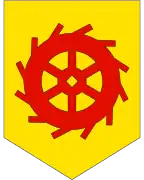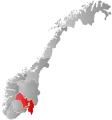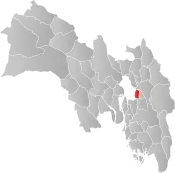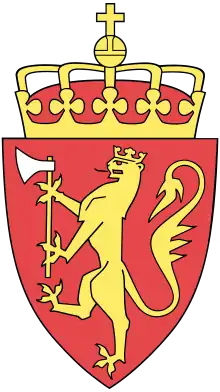Lørenskog
![]() Lørenskog is a municipality in Akershus in Viken county, Norway. A suburb of Oslo, it is part of the Oslo urban area and the traditional region of Romerike. The administrative centre of the municipality is the village of Lørenskog. Lørenskog was separated from the municipality of Skedsmo on 1 January 1908.
Lørenskog is a municipality in Akershus in Viken county, Norway. A suburb of Oslo, it is part of the Oslo urban area and the traditional region of Romerike. The administrative centre of the municipality is the village of Lørenskog. Lørenskog was separated from the municipality of Skedsmo on 1 January 1908.
Lørenskog kommune | |
|---|---|
 Coat of arms  Viken within Norway | |
 Lørenskog within Viken | |
| Coordinates: 59°53′56″N 10°57′51″E | |
| Country | Norway |
| County | Viken |
| District | Romerike |
| Administrative centre | Kjenn |
| Government | |
| • Mayor (2015) | Ragnhild Bergheim (Ap) |
| Area | |
| • Total | 71 km2 (27 sq mi) |
| • Land | 67 km2 (26 sq mi) |
| Area rank | 405 in Norway |
| Population (2017) | |
| • Total | 42,372 |
| • Rank | 22 in Norway |
| • Density | 527/km2 (1,360/sq mi) |
| • Change (10 years) | 16.1% |
| Demonym(s) | Lørenskoging Lørnskæving[1] |
| Time zone | UTC+01:00 (CET) |
| • Summer (DST) | UTC+02:00 (CEST) |
| ISO 3166 code | NO-3029 |
| Official language form | Bokmål[2] |
| Website | www |
General information
Name
The municipality (originally the parish) is named after the old (and no longer existent) Leirheimr farm. The first element is leirr which means "clay" and the last element is heimr which means "homestead" or "farm". Thus: "the farm built on clay ground". The suffix skógr (meaning "wood") was added later, changing the meaning to "the woodlands around the farm Leirheimr". Prior to 1918, the name was spelled "Lørenskogen".
Heraldry
Lørenskog's arms date from modern times. Granted on 26 July 1957, they show a red waterwheel on a gold background. Water-driven sawmills were once an important part of the municipality's economy.[3]

Lørenskog Church
Lørenskog Church (Lørenskog kirke) is a medieval era church. The building material was brick and quarried limestone. The church dates to ca. 1150. The church is of rectangular plan and has 140 seats. In 1608 the church received a pulpit. The west tower was made of wood and was erected in 1864. In the tower hangs two church bells, the larger made in 1874. Its walls are one meter thick, and the stones are held together with lime mortar. The exterior and interior plaster was repaired during the 1600s and 1700s. In 1956 old plaster was removed and walls re-plastered and painted. The current outward opening door was inserted in 1946. [4] [5]
Minorities
| Ancestry | Number |
|---|---|
| 1,359 | |
| 913 | |
| 753 | |
| 744 | |
| 535 | |
| 390 | |
| 362 | |
| 355 | |
| 322 | |
| 307 | |
| 282 | |
| 255 |
Geography
The municipality is located just east of the capital, Oslo, with many main roads going through it. Almost all the inhabitants live in the northern part of Lørenskog. The southern parts consist of forest, while farms and grain fields occupy the space in between. An important train station, Lørenskog Station, is situated in the district. Within Lørenskog, Losby is known for its waterwheel, which is represented in the municipal coat-of-arms of Lørenskog. Losby Golf and Country Club is located within the municipality.
Village
From 2006-2008, workers renovated the village of Lørenskog (the administrative center of the municipality), also called the "Metro Senter". This renovation includes a considerably larger shopping mall, a bus terminal with buses going in and out of Oslo every 15 minutes, possibly a future subway station, and the new Mailand Upper Secondary School.
Education
There are seven public elementary schools and four public high schools located in Kjenn, Hammer, Løkenåsen and Fjellsrud. In addition there are two Upper Secondary Schools, namely Lørenskog Upper Secondary School and Mailand Upper Secondary School.
Notable residents
- John Carew, Former Footballer
- M2M, Pop Duo
- Marit Larsen, Pop Artist
- Marion Raven, Pop-Rock Artist
- Johann Olav Koss, Former Speed Skater
- Pål Grotnes, Hockey Goalie
- Henning Berg, Former Footballer
- Maria Mena, Pop Artist
- Christina Vukicevic, Hurdler
- Ine Marie Eriksen Søreide, Minister of Defence
- Tom Hagen (businessman), business man and billionaire
Twin towns – sister cities
 Garching bei München, Germany
Garching bei München, Germany Järvenpää, Finland
Järvenpää, Finland Rødovre, Denmark
Rødovre, Denmark Täby, Sweden
Täby, Sweden
References
- "Navn på steder og personer: Innbyggjarnamn" (in Norwegian). Språkrådet.
- "Forskrift om målvedtak i kommunar og fylkeskommunar" (in Norwegian). Lovdata.no.
- "Kommunevåpenet" (in Norwegian). Lørenskog kommune. Archived from the original on 2011-06-10. Retrieved 2008-12-20.
- "Lørenskog kirke". Lørenskog kommune. Retrieved October 1, 2016.
- Sigrid Marie Christie, Håkon Christie. "Lørenskog kirke". Norges Kirker. Retrieved October 1, 2016.
- "Immigrants and Norwegian-born to immigrant parents, by immigration category, country background and percentages of the population". ssb.no. Archived from the original on 2 July 2015. Retrieved 29 June 2015.
- "Vennskapskommuner". lorenskog.kommune.no (in Norwegian). Lørenskog Kommune. Retrieved 2021-01-31.
External links
 Media related to Lørenskog at Wikimedia Commons
Media related to Lørenskog at Wikimedia Commons The dictionary definition of Lørenskog at Wiktionary
The dictionary definition of Lørenskog at Wiktionary- Municipal fact sheet from Statistics Norway
 Akershus travel guide from Wikivoyage
Akershus travel guide from Wikivoyage- The Losby waterwheel

